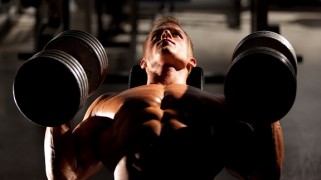 Dec 25: There’s a reason why you’re spending countless hours in the gym but still looking scrawny and not brawny: muscle mass isn’t built solely in the weight room. In fact, what you’re doing at the kitchen table–and even in the bedroom—may be more important for gaining muscle mass than what you’re lifting. (Of course what you’re lifting, and how often you’re lifting it, matters a lot too.) For any athlete looking to add size fast, the following four factors are critical.
Dec 25: There’s a reason why you’re spending countless hours in the gym but still looking scrawny and not brawny: muscle mass isn’t built solely in the weight room. In fact, what you’re doing at the kitchen table–and even in the bedroom—may be more important for gaining muscle mass than what you’re lifting. (Of course what you’re lifting, and how often you’re lifting it, matters a lot too.) For any athlete looking to add size fast, the following four factors are critical.
Essential Exercises
Isolation training, where you focus on a single muscle, is nearly pointless for athletes. If your goal is to develop size, you need to perform complex lifts that recruit several muscle groups at the same time. So ditch moves like arm curls in favor of full-body movements like Chin-Ups. You’ll cause more muscle stimulation throughout your body, leading to more muscle growth. The following eight exercises are essential to anyone looking to pack on muscle mass fast.
• Squat
• Deadlift
• Lunges
• Split Squat
• Bench Press
• Military Press
• Chin-Ups/Pull-Ups
• DB Rows
Correct Sets and Reps
Knowing the right exercises is only half of the muscle-building battle in the gym. The other half is knowing how many of those moves you should perform, and how frequently you should perform them. Thankfully, the National Strength and Conditioning Association (NSCA) has studied that exact subject, diligently working to determine the ideal combo of sets, reps and rest to optimize hypertrophy (the fancy word for “muscle growth”). Based on their studies, they recommend:
• Sets: 3-6
• Reps: 6-12
• Rest between sets: 30 to 90 seconds
• Workout frequency: 2 or 3 days per week
The NSCA also found that muscles need 48 hours of rest to fully recover from a workout. So if you whaled on your legs on Monday, don’t work them again until Wednesday.
A Powerful Diet
Of course you want to eat a well-rounded diet that provides plenty of nutrients through fruits, vegetables and whole grains, but the two most important dietary elements for muscle growth and development are protein and water. The NSCA recommends athletes consume about 1 gram of protein per pound of body weight per day. Remember to eat for the body you want, not the body you have. So if you weigh 170 pounds but want to get to 200, take in 200 grams of protein each day.
Since muscles are about 75% water, anyone looking to add size should be drinking plenty of H2O. A good target for men is to drink about 3.7 liters (about 125 oz.) per day, while women should aim for 2.7 liters (a little more than 90 oz.) per day. Since you lose water through sweat during workouts, you need to drink even more on gym days.
Proper Rest
You may think you’re getting “swole” in the gym, but in reality most muscle growth occurs during the REM cycle of sleep. So no matter how much you lift, you won’t get the growth you want if you’re not getting enough sleep. (Check out Secrets for Muscle-Building Sleep.)
Athletes should aim for at least eight hours of sleep per night—as many as 10 if they can spare the time. Rid your room of computers, TVs, phones, and other distractions that can disturb your sleep. And drop the room temperature to between 60 and 65 degrees Fahrenheit if possible. Cool temps induce sleepiness, helping you reach the deeper REM phase sooner.
Learn more about getting bigger by checking out STACK's Guide to Building Muscle.





Comments
Add new comment